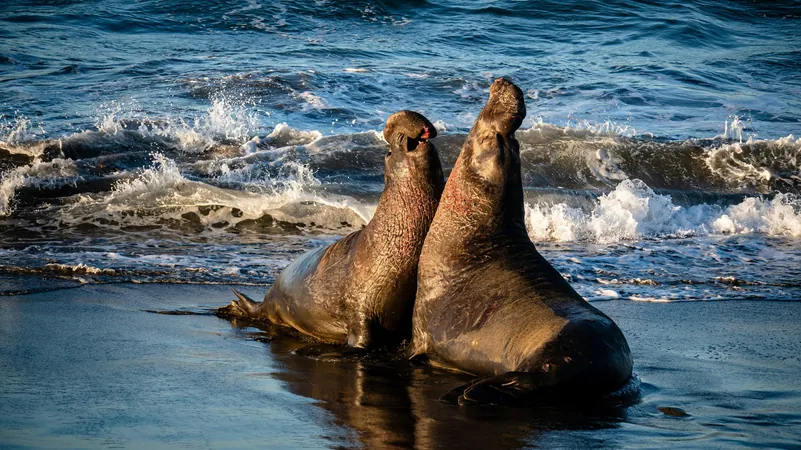
Once a Haven for Southern Elephant Seals, New Zealand Faces a Climate Crisis
2025-04-01
Author: Wei
When the first Polynesian settlers touched down on New Zealand's shores between 1200 and 1300 CE, they were greeted by a breathtaking scene: thousands of prehistoric sea lions and majestic southern elephant seals blanketing the pristine sandy beaches of an untouched land. Fast forward to today, and that vibrant marine life has largely vanished, overtaken by centuries of climate change and human intervention.
A groundbreaking study by researchers from Griffith University reveals that only 400 years ago, New Zealand's coastline was a veritable haven for southern elephant seals, creatures that now seem like ghosts of the past. This research paints a haunting picture of a time when these colossal mammals thrived, only to be pushed away from their natural habitats.
The findings suggest that southern elephant seals serve as a vital indicator—akin to the ‘canary in the coal mine’—for understanding the health of the Southern Ocean ecosystem. Associate Professor Nic Rawlence, a senior author of the study and director at the Otago Palaeogenetics Laboratory, noted, “At the time of human arrival in New Zealand, beaches were teeming with fur seals, prehistoric sea lions, and elephant seals, alongside numerous penguins.”
The research team, led by postgraduate students Andrew Berg from the University of Sydney and Megan Askew from Otago University, has shed light on how these seals once dominated the Southern Ocean. Their work, published in the journal *Global Change Biology*, employed advanced palaeogenetic techniques to analyze ancient DNA from bones, teeth, and sediments dating back thousands of years across New Zealand, Tasmania, and Antarctica.
Dr. Mark de Bruyn, another key author of the study, explained that both climate change and human actions drastically altered elephant seal populations during a relatively short evolutionary timeframe. “Ice Ages led to more sea ice surrounding Antarctica, compelling these seals to retreat to various refuges in South Africa, Australia, New Zealand, and South America, until they reexpanded as the climate warmed. However, human factors, such as indigenous hunting and European industrial sealing, led to their contraction, ultimately pushing them out of New Zealand and Australia.”
Understanding how these seals adapted to past climate shifts can offer crucial insights into their future resilience in the face of ongoing global climate change. The Southern Ocean is warming at an alarming rate, and this region's unique biodiversity faces existential threats. Analyzing genetic data from historical specimens reveals how these organisms can respond to change—a lesson we urgently need to heed.
The southern elephant seal, the largest pinniped and non-cetacean marine mammal, plays a critical role in its ecosystem as an apex predator. Yet it is now trapped in a sub-Antarctic habitat that is rapidly changing due to climate impacts. With its extended foraging periods lasting up to nine months, the seal relies on a vast biomass—its survival increasingly hangs in the balance.
“Given their complex evolutionary past, combined with the stresses of climate change and human impact, we must recognize the dire risks. Without decisive action to tackle climate change and safeguard marine ecosystems, southern elephant seals and the Southern Ocean’s biodiversity could face a bleak future,” cautioned Rawlence.
The lessons learned from the past are clear: if we hope to preserve what remains of New Zealand's natural heritage and its unique marine life, immediate action is necessary. Will we heed the warning of the southern elephant seal before it’s too late?



 Brasil (PT)
Brasil (PT)
 Canada (EN)
Canada (EN)
 Chile (ES)
Chile (ES)
 Česko (CS)
Česko (CS)
 대한민국 (KO)
대한민국 (KO)
 España (ES)
España (ES)
 France (FR)
France (FR)
 Hong Kong (EN)
Hong Kong (EN)
 Italia (IT)
Italia (IT)
 日本 (JA)
日本 (JA)
 Magyarország (HU)
Magyarország (HU)
 Norge (NO)
Norge (NO)
 Polska (PL)
Polska (PL)
 Schweiz (DE)
Schweiz (DE)
 Singapore (EN)
Singapore (EN)
 Sverige (SV)
Sverige (SV)
 Suomi (FI)
Suomi (FI)
 Türkiye (TR)
Türkiye (TR)
 الإمارات العربية المتحدة (AR)
الإمارات العربية المتحدة (AR)